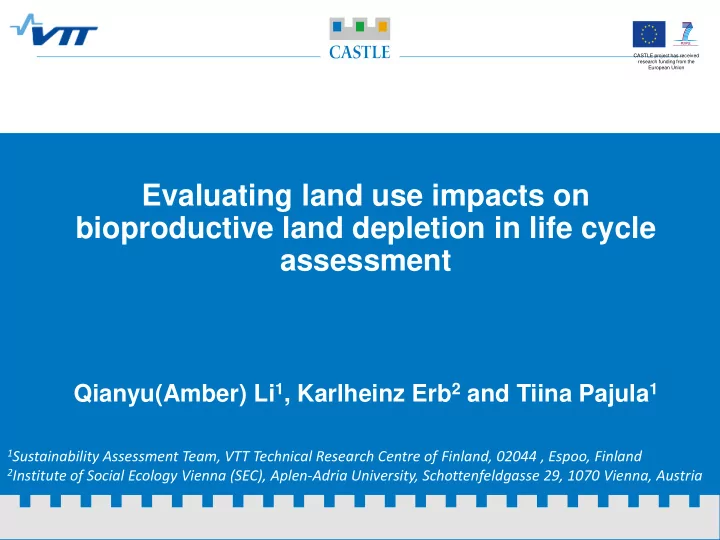

CASTLE project has received research funding from the European Union Evaluating land use impacts on bioproductive land depletion in life cycle assessment Qianyu(Amber) Li 1 , Karlheinz Erb 2 and Tiina Pajula 1 1 Sustainability Assessment Team, VTT Technical Research Centre of Finland, 02044 , Espoo, Finland 2 Institute of Social Ecology Vienna (SEC), Aplen-Adria University, Schottenfeldgasse 29, 1070 Vienna, Austria
Overview • Background • Objective • Method • Results and discussion • Conclusion and recommendation Conclusion & Background Objective Method Results Recommendation
Background • LCA (Life cycle assessment) • is a technique for addressing the potential environmental impacts with respect to the whole life cycle of a product or service. • When evaluating the environmental performance of using biotic resources, well-accepted operational LCA method is lacking. • land use impacts in LCA, according to UNEP- STEAC’s guideline (Canals, 2007) • Biodiversity • Ecological soil quality • Land productivity indicated under HANPP approach Conclusion & Background Objective Method Results Recommendation
Land Land Land use occupation transformation activities Land Urban, Untouched Agriculture Forest Grazing use Agriculture industry types Problems: • More from land occupation • Agriculture-based, not suitable for forest value chain . Conclusion & Background Objective Method Results Recommendation
Objective • Method development of LCA: in land use impact assessment on land productivity change from forest biomass cultivation Conclusion & Background Objective Method Results Recommendation
Method – LCIA method • Life cycle impact assessment (LCIA) method Impact category LCIA Characterization model Environmental mechanism Characterization factor Ref. ISO 14044 Conclusion & Background Objective Method Results Recommendation
Method – NPP • Human appropriation of net primary production (HANPP) approach is used for reflecting the land use induced land productivity change (Haberl, 2007). • NPP : NPP indicates the . amount of trophic energy available to be transferred to other levels. Not straightforward applied in LCA yet. Conclusion & Background Objective Method Results Recommendation
Method – HANPP LUC • HANPP LUC is served as a midpoint level characterisation factor (CF), expressed as: 𝑫𝑮 𝒋,𝒌 = 𝑰𝑩𝑶𝑸𝑸 𝑴𝑽𝑫 𝒋,𝒌 = 𝑶𝑸𝑸 𝒒𝒑𝒖 𝒋,𝒌 − 𝑶𝑸𝑸 𝒃𝒅𝒖 𝒋,𝒌 i denotes location, j denotes land use type, with unit as g C/ m 2 a • NPPpot is the natural potential vegetation, which without human intervention; • NPPact is the vegetation under current occupied land use type, i.e. forest . Conclusion & Background Objective Method Results Recommendation
Method – NPP pot • NPP pot can not be directly measured, as it is a hypothetical situation. • It is evaluated by three different approaches: • LPJ model – dynamic global vegetation model. – consider ecological parameters from site-specific research. • Miami model – empirical model, simplified relation between NPP, temperature and precipitation. • Results from literatures Conclusion & Background Objective Method Results Recommendation
Method – NPP act • NPP act is calculated by using data from: • Finnish National Forest inventory annual increment and area data for different tree species • IPCC report biomass extension factor (BEF) data and density data. • Literature (e.g. Gower, 2001) belowground part, understory part biomass production data . Conclusion & Background Objective Method Results Recommendation
Results – situation in Finland NPP act = 221.2 NPP pot Miami model underestimates the NPP pot for boreal forest. This result also coincides with Del Grosso (2008), Zaks (2007). Results for forest based on different models, with unit as g C/ m 2 a Conclusion & Background Objective Method Results Recommendation
Results – induced NPP reduction HANPP LUC Forest Agriculture 𝑰𝑩𝑶𝑸𝑸 𝑴𝑽𝑫 = 𝑶𝑸𝑸 𝒒𝒑𝒖 − 𝑶𝑸𝑸 𝒃𝒅𝒖 Impacts from forest just ~ 10% less slightly smaller than what from agriculture, so forest land use impacts should be assessed. Results for forest based on different models, with unit as g C/ m 2 a Conclusion & Background Objective Method Results Recommendation
Conclusion & recommendations • HANPP integrate into LCA? Possible, but i.e. tropic forest, temperate forest, all types of grazing land… • Impacts resulting from forest land use should not be omitted regarding sustainable bioeconomy. s patially consistent data-set covering all types of forest are needed for NPP simulation. Conclusion & Background Objective Method Results Recommendation
Conclusion & recommendations • The method need to be further evaluated in practice as the choice of NPPpot simulation method matter. a LCA case study with products containing different forest-based raw materials. Conclusion & Background Objective Method Results Recommendation
Acknowledgements • Colleagues from VTT Technical Research Centre of Finland for advise • Marie Curie actions for the financial support Thank you!
Recommend
More recommend